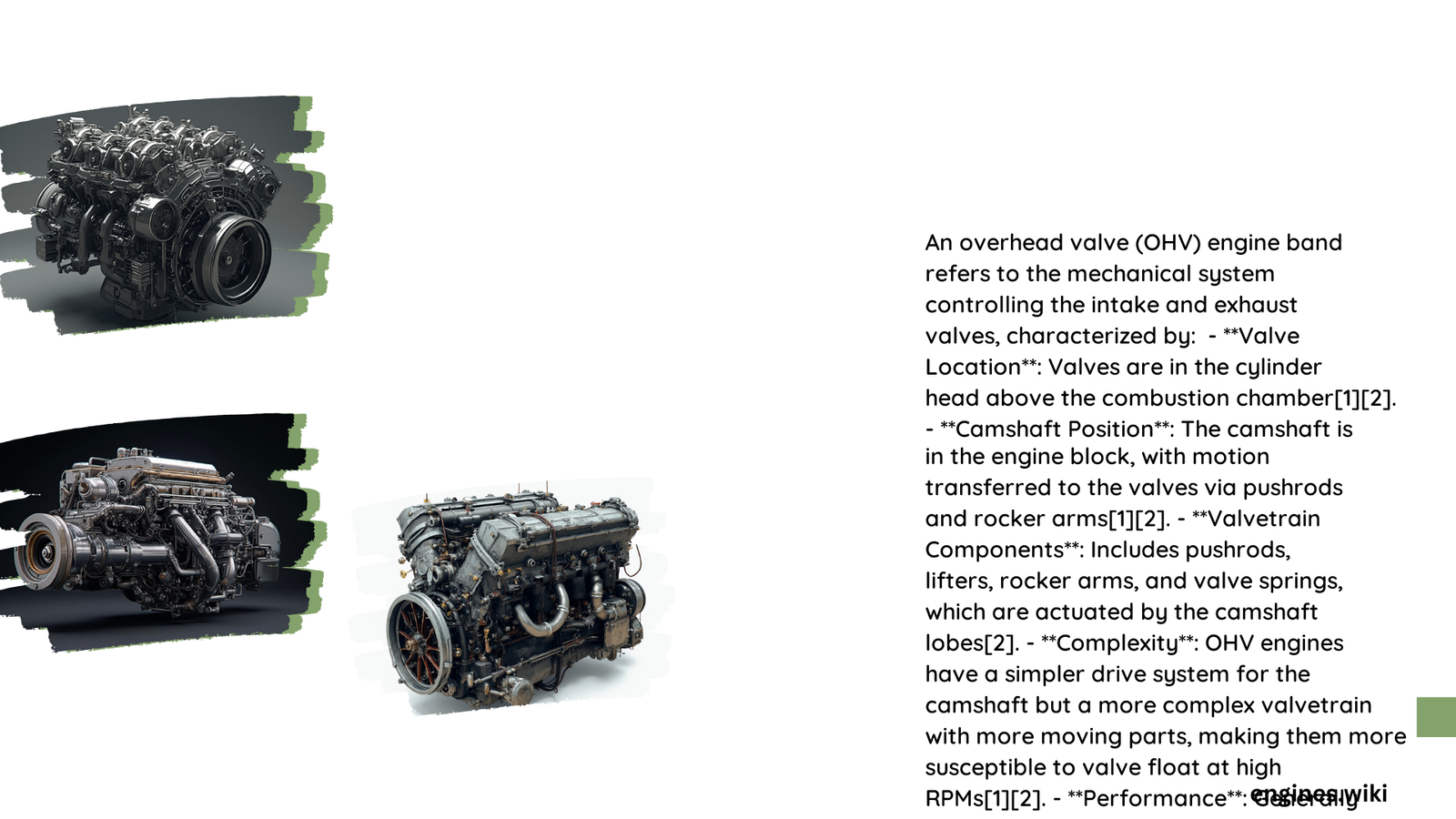Overhead valve (OHV) engine bands are critical components in the valve train system of internal combustion engines. These bands, typically made of high-strength materials, play a crucial role in valve operation, timing accuracy, and overall engine efficiency. OHV engine bands work in conjunction with other components such as camshafts, lifters, and rocker arms to ensure precise valve movement and optimal engine performance.
What are the Key Specifications of Overhead Valve Engine Bands?
Overhead valve engine bands, while not a specific component, are integral to the valve train system in OHV engines. The specifications of the valve train components that work together to form the ‘band’ include:
- Valves:
- Material: High-strength stainless steel or chrome-moly steel
-
Configuration: Typically two valves per cylinder
-
Lifters:
- Type: Hydraulic or solid
- Material: Steel or aluminum
-
Function: Maintain precise clearance between camshaft and valve stem
-
Pushrods:
- Material: Steel
-
Angle: Often set at 45 degrees to the cylinder centerline
-
Rocker Arms:
- Material: Steel or aluminum
-
Type: Standard or roller
-
Camshaft:
- Location: Center of the engine block
- Drive: Timing chain or gear
| Component | Material | Function |
|---|---|---|
| Valves | Stainless steel / Chrome-moly steel | Control gas flow in/out of cylinders |
| Lifters | Steel / Aluminum | Transmit cam lobe motion to pushrods |
| Pushrods | Steel | Transfer motion from lifters to rocker arms |
| Rocker Arms | Steel / Aluminum | Actuate valves based on pushrod movement |
| Camshaft | Steel | Determine valve timing and lift |
How Do Overhead Valve Engine Bands Influence Engine Performance?

Overhead valve engine bands significantly impact engine performance in several ways:
- Valve Timing Accuracy:
- The precise interaction of camshaft, lifters, pushrods, and rocker arms ensures accurate valve timing.
-
Proper timing optimizes fuel combustion and exhaust gas evacuation.
-
Valve Lift:
- The design of the valve train components determines the valve lift.
-
Correct lift is crucial for optimal airflow and combustion efficiency.
-
Engine Efficiency:
- OHV design allows for better engine breathing and more efficient combustion.
-
Central camshaft location and pushrod arrangement contribute to precise valve control.
-
Power Output:
- Efficient valve operation leads to improved power output.
- OHV engines often balance power and fuel efficiency effectively.
What are the Maintenance Requirements for Overhead Valve Engine Bands?
Proper maintenance of overhead valve engine bands is essential for longevity and performance:
- Regular Inspections:
- Conduct visual checks during routine maintenance (e.g., oil changes, tune-ups).
-
Inspect lifters, pushrods, and rocker arms for wear and proper clearance.
-
Lubrication:
- Ensure proper engine oil level and viscosity.
-
Regular oil changes are crucial for valve train component longevity.
-
Component Replacement:
- Replace worn lifters, bent pushrods, or damaged rocker arms promptly.
-
Costs can range from $500 to $2,000, depending on the extent of repairs needed.
-
Valve Adjustments:
- Some OHV engines require periodic valve lash adjustments.
- Follow manufacturer specifications for adjustment intervals and procedures.
What are the Advantages of Overhead Valve Engine Designs?
Overhead valve engine designs offer several benefits:
- Compact Design:
- OHV engines often have a lower overall height compared to overhead cam designs.
-
This allows for better packaging in various vehicle types.
-
Simplicity:
- Fewer components compared to some other valve train designs.
-
Can lead to easier maintenance and potentially lower production costs.
-
Low-End Torque:
- OHV engines often excel in producing strong low-end torque.
-
Beneficial for applications requiring good pulling power at lower RPMs.
-
Fuel Efficiency:
- When properly designed, OHV engines can offer competitive fuel efficiency.
-
The balance of power and efficiency makes them suitable for various applications.
-
Durability:
- With proper maintenance, OHV engines can be highly durable.
- Many long-lasting truck and industrial engines use OHV designs.
How Do Overhead Valve Engine Bands Compare to Other Valve Train Designs?
When comparing overhead valve engine bands to other valve train designs:
- vs. Overhead Cam (OHC) Engines:
- OHV: Simpler design, potentially lower cost
-
OHC: Often allows for higher RPM operation, more valves per cylinder
-
vs. Pushrod Engines:
- OHV and pushrod engines are essentially the same design
-
Both use a camshaft in the block with pushrods actuating the valves
-
vs. Desmodromic Valve Systems:
- OHV: Uses springs for valve closure, simpler design
-
Desmodromic: Mechanical closure of valves, allows for higher RPM but more complex
-
vs. Camless Valve Actuation:
- OHV: Traditional mechanical system
- Camless: Uses electromagnetic or hydraulic actuators, offers more precise control but higher complexity
In conclusion, overhead valve engine bands, while not a specific component, represent the collective operation of various valve train parts in OHV engines. Their design and implementation significantly influence engine performance, efficiency, and maintenance requirements. Understanding these aspects is crucial for both engine designers and maintenance professionals to optimize engine operation and longevity.
References:
1. MA-82106 V-type 8-cylinder 4-stroke overhead valve (OHV) 5.0L supercharged ignition high-speed engine model
2. Engine Specification Sheet Operating Speed (RPM … – Cummins
3. 4-CYCLE OVERHEAD VALVE ENGINES – Tecumseh Power
